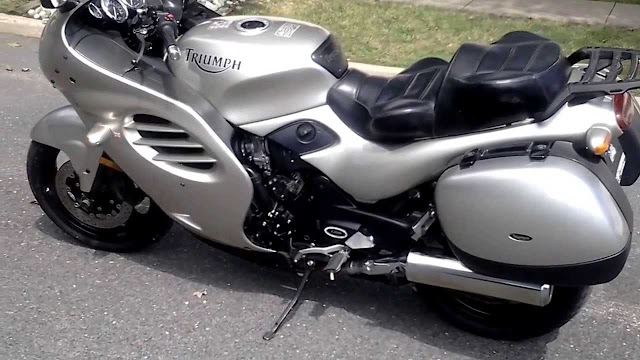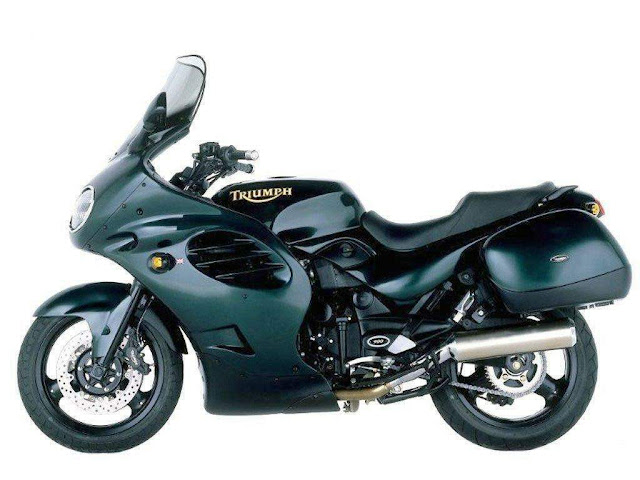Triumph Trophy 1200
Previous Triumphs might not have encouraged a knee-down cornering style, but the Trophy was from a new generation.
The Trophy 's styling was neat and efficient rather then spectacular, and the same could he said of its engineering. When Britain's reborn Triumph began production in 1991. few people expected the first model to be a powerful superbike with a liquid-cooled engine and monoshock suspension - let alone a fully-faired, l I80cc, 16-valve four that produced 125bhp and purred smoothly to a top speed of over 150mph (241 km/h). From a manufacturer whose name had most recently been associated with old-fashioned air-cooled twins, the Trophy 1200 was a sensation. Perhaps the greatest compliment that was paid to the new British sports-tourer was that it could have been built by one of the big four Japanese firms. In fact the Trophy, like the naked Trident and sportier Daytona models that followed shortly afterwards, had been created by a team led by John Bloor. a multi-millionaire builder. Bloor had bought bankrupt Triumph in 1983 and spent the intervening period creating a state-of-the-art factory at Hinckley, near the former Triumph base at Meriden in the English Midlands.
The Trophy 1200 sports-tourer was the largest of an initial range of six bikes that were built using a unique modular concept. All six used an identical steel spine frame. Triumph’s three- and four- cylinder engines with choice of short- or long- stroke crankshafts gave four engine capacities from 750cc triple to I200cc four. In other respects the Trophy’s dohc, liquid-cooled 16-valve engine layout was conventional.
That large-diameter steel spine frame used the engine as a stressed member. The frame held 43mm forks and a vertical rear monoshock, both from Japanese specialists Kayaba. Brakes were also made in Japan, by Nissin. Some British bike enthusiasts were critical of this, but Britain's motorcycle parts industry was a shadow of its former self, and Bloor had no time for sentiment.
Nor did most superbike-buying enthusiasts, but Triumph did not need to rely on nostalgia to make the Trophy a success. Its big motor was superbly strong, with a broad power band that delivered crisp acceleration everywhere between 2000rpm and the 9500rpm redline. The Trophy cruised effortlessly at l OOmph (I61km/h) with plenty of speed in hand. It was smooth, thanks to twin balancer shafts, and its six-speed gearbox was slick. Crucially this Triumph, unlike numerous predecessors, was also reliable and oil-tight.
Triumph's steel spine frame was slightly dated when compared to twin-spar aluminium layouts, and the Trophy was quite a tall bike with a high centre of gravity. At 529lb (240kg) it was fairly heavy, too. But it handled well, combining flawless straight-line stability with neutral steering and good quality suspension that gave plenty of control along with a high level of comfort.
Other impressive features included an efficient full fairing, large fuel tank and comfortable dualseat with pillion grab-rail. Some other details such as the small mirrors and mediocre headlamp were less impressive, but most people who rode the Trophy were surprised to find it competitive with the best Japanese sports-tourers. That would have been impressive for any new bike, let alone a new manufacturer’s debut model. The Trophy 1200 was a Triumph not only in name.
Triumph's reputation for performance leapt in 1993 when the British firm released the Daytona 1200, powered by a tuned, 145bhp version of the Trophy's four-cylinder engine. Although named after the Daytona speedway in Florida, scene of famous Triumph wins in the 1960s, the 1200 was not a race-replica but a muscular roadburner with a top speed of 160mph (257km/h). Its modular steel frame held high-quality cycle parts that helped give good handling despite over 500lb (227kg) of weight. The Daytona wasn't the world's sharpest sports bike, but it generated plenty of speed and excitement.
Specification Triumph Trophy 1200 (1991)
Engine Liquid-cooled dohc 16-valve four
Capacity 1180cc (76 x 65mm)
Maximum power 125bhp @ 9000rpm
Transmission Six-speed, chain final drive
Frame Steel spine
Suspension Telescopic front; single shock rear
Brakes Twin disc front; disc rear
Weight 529lb (240kg)
Top speed 153mph (246km/h)


















0 comments: